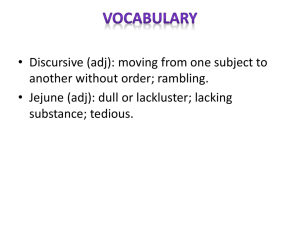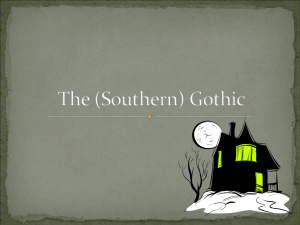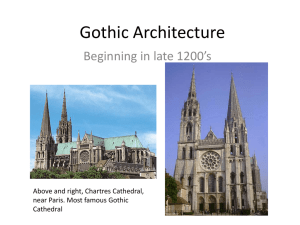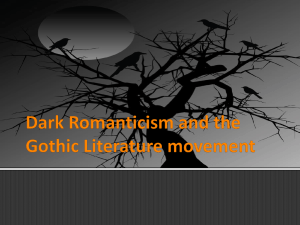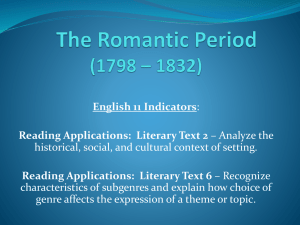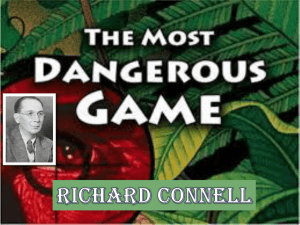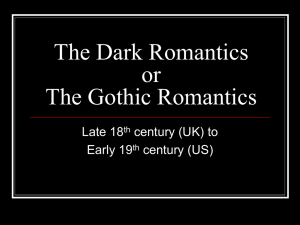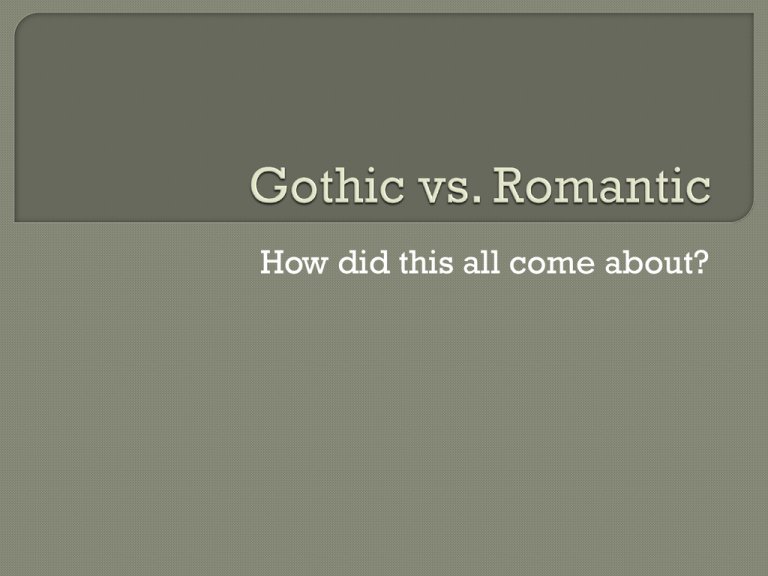
How did this all come about?
The first British novel was published in 1719 =
Robinson Crusoe by Daniel Defoe
As a new invention, these novelists
experimented with form and content.
Epistolary
structure
Amorous & Gothic fiction
Popular but shameful!
Shift from order and reason to emotion and
imagination
If science explains our existence, where is there
space for feeling, reflection, thinking,
exploration, and emotion?
Romantics believed that science could NOT fully
grasp the essence of “human.”
“head vs. heart” OR “sense vs. sensibility”
• Jane Austen novel- Sense and Sensibility 1811
Lyrical Ballads- 1798/ Wordsworth & Coleridge
“Big 6”
•
•
•
•
•
•
Shelley
Keats
Byron
Coleridge
Wordsworth
Blake
“Satanic School”- Byron & Shelley
• People saw Romantic writing as morally reproachable!
Past- return to Medieval Times & Knight’s tales
Imagination- what man can create with his mind
that cannot be created with science
Common Man- everyday life/ not just stories
about aristocrats
Idealization of Women- a return to the chivalry of
the Medieval Times
Nature- growing Industrialization & the Industrial
Revolution makes man appreciate nature even
more
Emotion- feelings as more true to the human
experience than scientific formulas
“Gothic
vs. Romantic” by Hume
“Shift
from Neoclassical ideals of order and
reason toward Romantic belief in emotion
and imagination”
Refers
to Burke’s essay on the sublime“‘terror is the author’s principal engine’ to
grip and affect the reader”
“one
of a kind treatment of the
psychological problem of evil”
“the
Gothic form had a curious appeal in
terms of weaving a beauty of the
unpleasant, the horrifying and even
grotesque”
• This had a powerful impact on the human senses
which Romantic fiction was all about.
• Gothic fiction gave way to Romantic fiction
Writers and critics in this period treated
Gothic works like The Castle of Otranto—
at the time, collectively referred to as
“terrorist literature,” for their ability to
induce feelings of horror—both as
objects of scorn, and as (often
unacknowledged) sources of inspiration.
The Gothic was a matter of particular
concern for writers and critics in the late
eighteenth and early nineteenth-centuries
primarily because it was a phenomenally
popular literary genre, particularly for
women readers.
Ex. Catherine Morland in Jane Austen’s
Northanger Abbey hiding The
Mysteries of Udolpho by Anne Radcliffe
One of the most common accusations against the Gothic was that it was
fundamentally immoral: Gothic romances were said to corrupt their readers’ minds
and encourage social disorder. The pedagogical effect of the genre on children was
thought to be especially dangerous. An anonymous critic, who wrote a polemic
against “Terrorist Novel Writing” in The Spirit of the Public Journals for 1797,
denounced the Gothic for illustrating grotesque fantasies that defied the limits of
common sense, claiming that these fantasies were bad moral lessons, which
“carr[y] the young reader’s imagination into such a confusion of terrors, as must be
hurtful. Unlike “useful” novels, which accurately depict “human life and manners,
with a view to direct the conduct in the important duties of life, and to correct its
follies,” Gothic romances illustrate bizarre situations “reaped from the distorted
ideas of lunatics.”
In this critic’s view, Gothic romances were hardly idle enjoyments: they were
insidious implements of chaos that would ruin young people’s capacity for labour
and for public service. This all-too-common “taste for the marvelous and the
terrible” was, as the Monthly Review stated in 1796, akin to a plague, “an infection,”
that must be stamped out for the health of the nation (qtd. in Epstein 205).
The effect of the Gothic on women was thought to be, if anything, even more
frightening. Terrorist fiction was accused of producing a cohort of mannish women,
who would rather dream of death-defying adventures and thrilling romances than
settle down, get married, and attend to their feminine duties.
In the eyes of conservative critics, a whole generation of women—
and, by extension, a whole generation of wives and mothers, the
very future of England—was in danger of contamination by the
Gothic. The sanctity of matrimony itself was threatened by these
books, which trained women to imagine marriage not as a solemn
union before the watchful eyes of Church and State, but as a
dramatic spectacle, in which bride and groom would pass
“through long and dangerous galleries, where the lights burn
blue, the thunder rattles, and the great window at the end presents
the hideous visage of a murdered man” (“Terrorist” 601). In a
world where women preferred to fantasize about confronting hosts
of ghouls and nightmares with a dashing young man than
marrying the proper gentleman selected for them by their
parents, it was not hard for conservatives to imagine that social
decay was imminent. By “emphasizing power relations and
entaglements, and developing themes of veiling and entrapment,”
the Gothic taught women to do the unthinkable: suspect the men in
their lives—husbands, fathers, and priests—of potentially
harbouring malevolent intentions towards them (Epstein 205).
Gothic romances were disparaged not only for filling women’s
heads with impossible dreams and potentially turning females
against their male rulers, but also for touting profligacy and
indolence.
Anyone wanting to make a quick dollar
could successfully write a bestselling
Gothic romance. Gothic authors were
accused of being less artists than
manufacturers, less writers than druggists
following pre-made prescriptions, pushing
vast quantities of mass-produced novels
onto the market. The entire genre was
effectively maligned by such attacks as a
bourgeois conspiracy: a secret
moneymaking pact between greedy
booksellers, printers, and hack writers.
Coleridge held a derogatory opinion of Gothic novels. His friend
and literary collaborator William Wordsworth took many
malicious, in-direct snipes at the Gothic in the preface to the
second edition of Lyrical Ballads, the foundational work of English
Romanticism. Wordsworth derided the Gothic—which he
pejoratively foreignized as “frantic novels, sickly and stupid
German tragedies”—for stirring up overly strong, forceful
emotions like terror and despair (Wordsworth 267). In his view,
Gothic novels were textual drugs, which numbed human faculties
of sympathy and imagination, and their devoted readers were
addicts possessed by a “degrading thirst after outrageous
stimulation” (Wordsworth 267). The genre employed a plethora of
“gross and violent stimulants,” which obscured, rather than
revealed, the nature of reality (Wordsworth 266). Stylistically, the
Gothic was overwrought in its prose and melodramatic in its
themes, littered with “gaudiness and inane phraseology”
(Wordsworth 264). In many respects, Wordsworth theorized what
he and Coleridge were doing in their poems—i.e. using
unadorned, simple language to meditate “in tranquility” upon
powerful emotions that were experienced by ordinary, “rustic”
men and women, and induced by everyday situations in nature—
as the polar opposite of the Gothic. Romantic poetry was akin to a
twelve-step program for weaning society off its addiction to
extravagant Gothic romances.
What Romantic and Gothic literature share is a belief that the chief
role of literature should be to arouse and channel primal human
affects and emotions like fear, wonder and eroticism. Such
sentiments are powerful and potentially transgressive, having the
capacity to unsettle rigid hierarchical social divisions, which is
why both Gothic and Romantic authors were, at times, considered
deviant by England’s establishment. While Gothic works like The
Castle of Otranto, which are notorious for having wooden, stock
characters and predictable situations, focus on surfaces,
externalities and seemingly superficial details, Romantic works
tend to focus on depths—the rich, lively, complex depths of the
natural world and the human psyche in particular. We can interpret
the Gothic, and all of the complicated responses to it, as the
symptoms of a society struggling to think through the implications
of a great many significant changes: changes in the extent and
meaning of literacy, and changes in how humans understand their
own lives and the lives of people around them.
1764
Generally
regarded as the first Gothic
novel ever written
Built a home called Strawberry Hill in the
classic Gothic architecture before his
Victorian successors would adopt the
style

